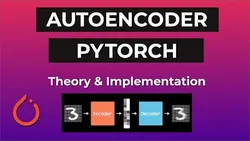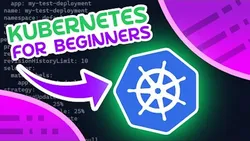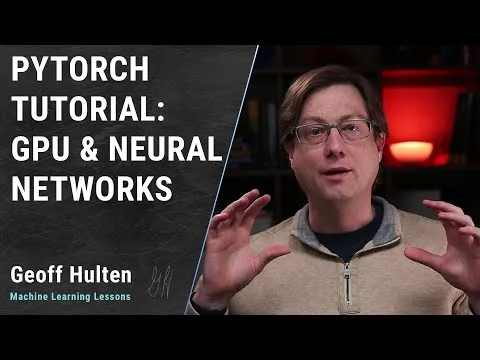
Autoencoder In PyTorch - Theory & Implementation 
This course provides an introduction to Autoencoders in PyTorch, covering both theory and implementation. It begins with data loading, followed by a simple Autoencoder and a training loop. The course then moves on to plotting images and a CNN Autoencoder, before concluding with an exercise for the student. This course is ideal for those looking to gain a comprehensive understanding of Autoencoders in PyTorch. ▼
ADVERTISEMENT
Course Feature
![]() Cost:
Cost:
Free
![]() Provider:
Provider:
Youtube
![]() Certificate:
Certificate:
Paid Certification
![]() Language:
Language:
English
![]() Start Date:
Start Date:
On-Demand
Course Overview
❗The content presented here is sourced directly from Youtube platform. For comprehensive course details, including enrollment information, simply click on the 'Go to class' link on our website.
Updated in [February 21st, 2023]
Autoencoder In PyTorch - Theory & Implementation is a comprehensive course that covers the fundamentals of Autoencoders and their implementation in PyTorch. Learners will gain an understanding of the theory behind Autoencoders, including data loading, simple Autoencoder, training loop, and plotting images. They will also learn how to implement a Convolutional Neural Network Autoencoder (CNN Autoencoder) and practice their skills with an exercise. This course is ideal for those who want to gain a deeper understanding of Autoencoders and their application in Machine Learning, Neural Networks, Deep Learning, and Artificial Intelligence.
[Applications]
After completing this course, students can apply the knowledge they have gained to create their own Autoencoders in PyTorch. They can use the data loading, training loop, and plotting images techniques to create their own Autoencoders. Additionally, they can use the CNN Autoencoder to create more complex Autoencoders. Finally, they can use the exercise provided to further their understanding of Autoencoders in PyTorch.
[Career Paths]
1. Data Scientist: Data Scientists use a variety of techniques to analyze and interpret data, such as machine learning, deep learning, and natural language processing. They are responsible for developing models and algorithms to identify patterns and trends in data, and then use those insights to inform decisions. The demand for data scientists is growing rapidly, and the field is expected to continue to expand in the coming years.
2. Machine Learning Engineer: Machine Learning Engineers are responsible for designing, developing, and deploying machine learning models. They use a variety of techniques, such as supervised and unsupervised learning, to create models that can be used to make predictions and decisions. The demand for machine learning engineers is also growing rapidly, and the field is expected to continue to expand in the coming years.
3. Artificial Intelligence Engineer: Artificial Intelligence Engineers are responsible for designing, developing, and deploying AI-based systems. They use a variety of techniques, such as deep learning, natural language processing, and computer vision, to create systems that can be used to make decisions and automate processes. The demand for AI engineers is also growing rapidly, and the field is expected to continue to expand in the coming years.
4. Autoencoder Developer: Autoencoder Developers are responsible for designing, developing, and deploying autoencoders. Autoencoders are a type of neural network that can be used to compress data and extract features from it. Autoencoders are becoming increasingly popular in the field of machine learning, and the demand for autoencoder developers is expected to continue to grow in the coming years.
[Education Paths]
1. Bachelor of Science in Computer Science: This degree path provides students with a comprehensive understanding of computer science fundamentals, including programming, software engineering, computer architecture, and algorithms. It also covers topics such as artificial intelligence, machine learning, and data science. As technology continues to evolve, the demand for computer science professionals is expected to grow significantly.
2. Master of Science in Artificial Intelligence: This degree path focuses on the development of intelligent systems and the application of artificial intelligence techniques to solve real-world problems. Students learn about machine learning, deep learning, natural language processing, and computer vision. This degree is ideal for those who want to pursue a career in the field of artificial intelligence.
3. Master of Science in Data Science: This degree path focuses on the analysis and interpretation of large datasets. Students learn about data mining, machine learning, and predictive analytics. This degree is ideal for those who want to pursue a career in the field of data science.
4. Doctor of Philosophy in Machine Learning: This degree path focuses on the development of advanced machine learning algorithms and their application to real-world problems. Students learn about deep learning, reinforcement learning, and natural language processing. This degree is ideal for those who want to pursue a career in the field of machine learning.
Course Provider

Provider Youtube's Stats at AZClass
Discussion and Reviews
0.0 (Based on 0 reviews)
Explore Similar Online Courses

Facebook DETR ML Coding Series End to end object detection with transformers

An Introduction To Kubernetes - For Beginners

Python for Informatics: Exploring Information

Social Network Analysis

Introduction to Systematic Review and Meta-Analysis

The Analytics Edge

DCO042 - Python For Informatics

Causal Diagrams: Draw Your Assumptions Before Your Conclusions

Whole genome sequencing of bacterial genomes - tools and applications

PyTorch Tutorial - Neural Networks & GPU

Applied Deep Learning with PyTorch - Full Course


Start your review of Autoencoder In PyTorch - Theory & Implementation